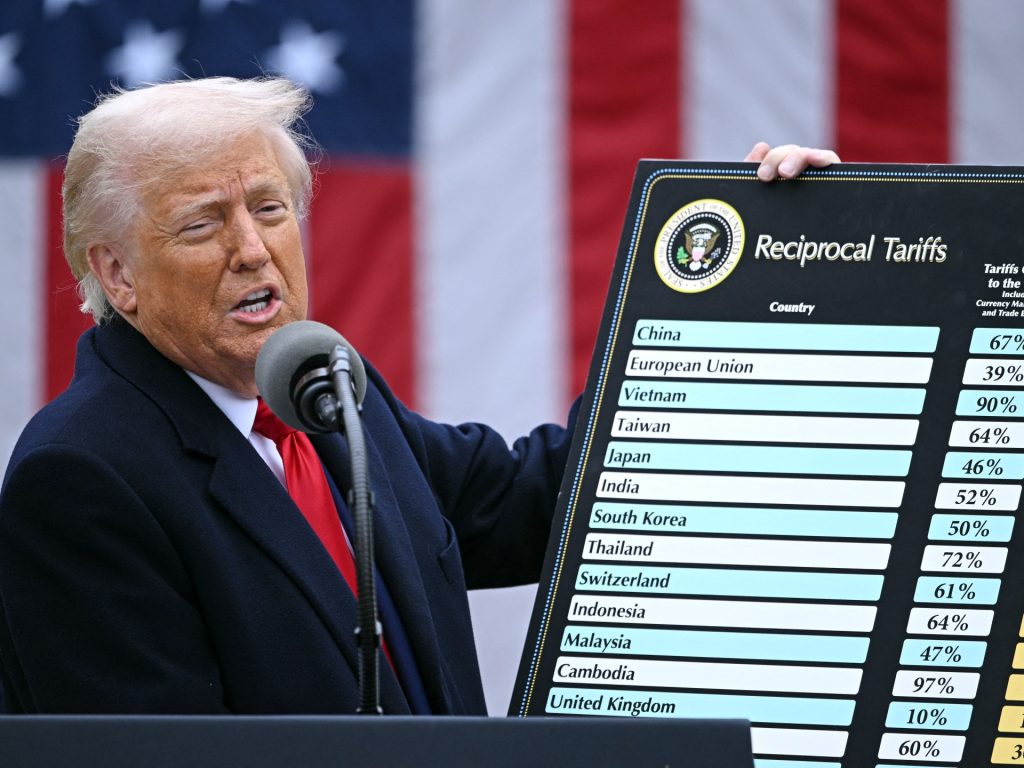President Donald Trump on Wednesday announced a range of reciprocal tariffs targeting almost all countries that the United States trades with, taking a sledgehammer to Washington’s longstanding advocacy of free trade and globalisation.
Trump’s latest tariffs, which build on a series of similar steps he has taken since returning to office on January 20, are going to hit the countries with which Washington has large trade deficits, or that impose heavy tariffs on US goods. In 2023, the US imports were worth $1.1 trillion more than its exports; no other country has as large a trade deficit as the US.
Trump’s reciprocal tariffs also target countries like Syria, which has faced Israeli attacks since the overthrow of President Bashar al-Assad in December 2024, and Myanmar, which is reeling from earthquake damage amid a civil war. They also target economies already struggling to balance their books, depending on loans from the International Monetary Fund, such as Sri Lanka and Pakistan.
Here is how each country will specifically be targeted by Trump’s tariffs and the few sectors that are — for now — exempt from the penalties.
What did Trump say?
Trump announced the reciprocal tariffs in an executive order alongside an address in the Rose Garden at the White House on Wednesday. Trump had been describing April 2 as “Liberation Day”.
In the executive order, Trump said while the US trading policy has been built on the principle of reciprocity, taxes and barriers on US products by its trading partners had hurt the US.
The tariffs, he said, were a response. These reciprocal tariffs will come into effect on April 9.
During his address, Trump made the argument that the US is charging its trading partners with smaller tariffs compared with the tariffs and non-tariff barriers that the partners impose on the US.
“For decades, our country has been looted, pillaged, raped and plundered by nations near and far, both friend and foe alike,” Trump said.
Holding up a chart of the new reciprocal tariffs, Trump cited the example of China, which he claimed charged US products with an average 67 percent tariff. “We’re going to be charging [China with] a discounted reciprocal tariff of 34 percent,” he said. “They charge us, we charge them less. How can anybody be upset? They will be because we’ve never charged anybody anything.”
But the effective tariff on China will actually be higher — and some countries will now be tariffed higher than the duties they levy on US imports. Chinese goods will face a 34 percent reciprocal tariff in addition to the 20 percent tariff that Trump imposed earlier, bringing the overall tariff on Chinese goods to 54 percent, close to his campaign promise of 60 percent. In 2024, China was the second-largest trading partner of the US.
How much will each country be tariffed?
The White House released an annexe of 57 target countries, territories and blocs which will face the increased tariffs. These include:
Algeria: 30 percent
Angola: 32 percent
Bangladesh: 37 percent
Bosnia and Herzegovina: 36 percent
Botswana: 38 percent
Brunei: 24 percent
Cambodia: 49 percent
Cameroon: 12 percent
Chad: 13 percent
China: 34 percent (in addition to the 20 percent imposed earlier)
Democratic Republic of the Congo: 11 percent
Equatorial Guinea: 13 percent
European Union: 20 percent
Falkland Islands: 42 percent
Fiji: 32 percent
Guyana: 38 percent
India: 27 percent
Indonesia: 32 percent
Iraq: 39 percent
Israel: 17 percent
Ivory Coast: 21 percent
Japan: 24 percent
Jordan: 20 percent
Kazakhstan: 27 percent
Laos: 48 percent
Lesotho: 50 percent
Libya: 31 percent
Liechtenstein: 37 percent
Madagascar: 47 percent
Malawi: 18 percent
Malaysia: 24 percent
Mauritius: 40 percent
Moldova: 31 percent
Mozambique: 16 percent
Myanmar: 45 percent
Namibia: 21 percent
Nauru: 30 percent
Nicaragua: 19 percent
Nigeria: 14 percent
North Macedonia: 33 percent
Norway: 16 percent
Pakistan: 30 percent
Philippines: 18 percent
Serbia: 38 percent
South Africa: 31 percent
South Korea: 26 percent
Sri Lanka: 44 percent
Switzerland: 32 percent
Syria: 41 percent
Taiwan: 32 percent
Thailand: 37 percent
Tunisia: 28 percent
Vanuatu: 23 percent
Venezuela: 15 percent
Vietnam: 46 percent
Zambia: 17 percent
Zimbabwe: 18 percent
Are other countries tariffed too?
Yes. Apart from the 57 on the list announced on Wednesday, Trump has also imposed a flat 10 percent tariff on products coming from almost all the other trading partners of the US.
He did this by invoking the International Emergency Economic Powers Act of 1977.
Some of the leading countries that will face this 10 percent tariff rate on all exports to the US include:
United Kingdom
Australia
Singapore
Brazil
New Zealand
Turkiye
United Arab Emirates
Saudi Arabia
Chile
These tariffs will come into effect on April 5.
What about Canada and Mexico?
While Canada and Mexico were not on the list of countries slapped with the latest tariffs, both US neighbours already face heavy tariffs.
On February 1, Trump signed executive orders imposing 25 percent tariffs on all goods imported from Mexico and Canada. Those tariffs were suspended for a month after negotiations between Trump and the leaders of the two countries.
In early March, Trump resurrected those tariffs, but on March 6, exempted goods that fall under the United States-Mexico-Canada Agreement (USMCA) from these tariffs on March 6.
Non-USMCA-compliant energy and potash face a 10 percent tariff. All other non-USMCA-compliant products from Mexico and Canada continue to face 25 percent tariffs.
The White House on Wednesday reaffirmed that the tariffs on Mexico and Canada remain in place.
What products are exempt?
The exempt products include copper, pharmaceuticals, semiconductors, lumber articles, energy products and certain critical minerals that are unavailable in the US.
On March 26, Trump signed an executive order imposing 25 percent tariffs on auto imports and certain automobile parts. No additional tariffs on these products were announced on Wednesday.


